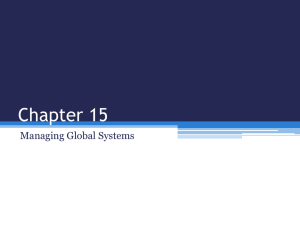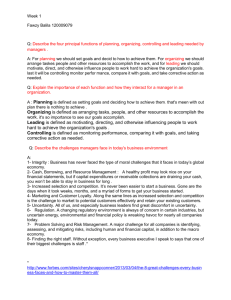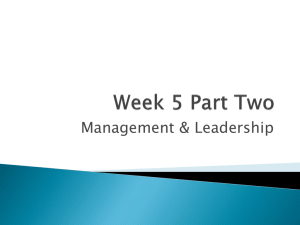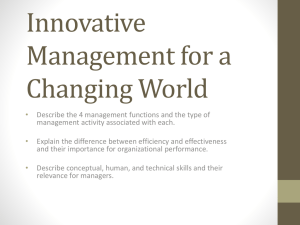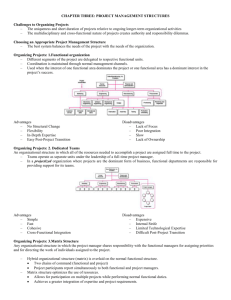PowerPoint
advertisement
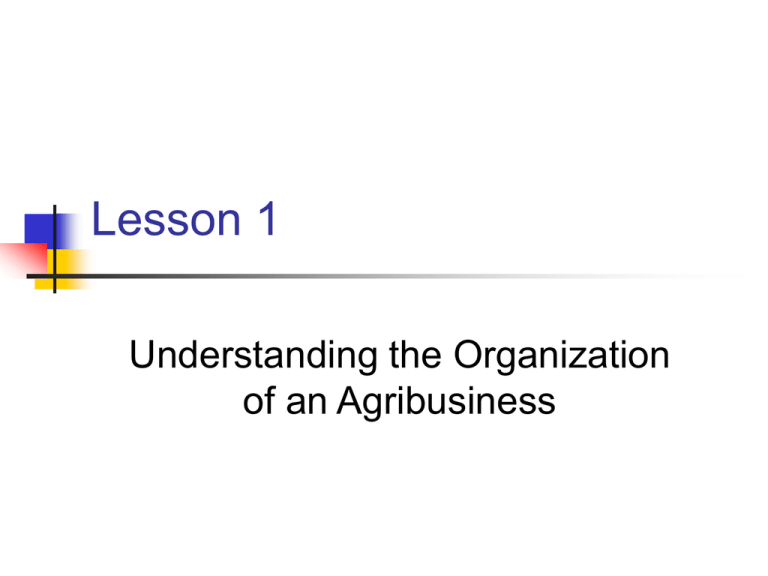
Lesson 1 Understanding the Organization of an Agribusiness Next Generation/Common Core Standards Addressed CCSS.ELA Literacy.RST.9‐10.8 Assess the extent to which the reasoning and evidence in a text support the author’s claim or a recommendation for solving a scientific or technical problem. CCSS.ELA Literacy. RST.11‐12.9 Synthesize information from a range of sources (e.g., texts, experiments, simulations) into a coherent understanding of a process, phenomenon, or concept, resolving conflicting information when possible Agriculture, Food and Natural Resource Standards Addressed! CRP.01.02 Evaluate and consider the near-term and long-term impacts of personal and professional decisions on employers and community before taking action. CRP.01.02.02.a. Classify professional decisions by their near- and long-term impact on employers and community (e.g., decisions involving: financials, business goals, processes, customer satisfaction, corporate image, etc.). Bell Work - Student Objectives Define organizing, organization, and organizational structure. Identify the basic principles of good business organization. Identify the three functions of management in a business. Describe a business organizational chart. Vocabulary Compensation Conglomerate organization Finance Horizontal integration Marketing Organization Organizational chart Organizational structure Organizing Resources Vertical integration Interest Approach Bring two students to the front of the room. Ask each of them which stack they’d like to refile. Why? Explain Ask students to consider what would happen if a business were as unorganized as that stack of units. How much work would they get done? Discuss the importance of an organized locker, book bag, or desk. Organizing One of the main components of management. Without it a business will have difficulty carrying out its mission and plans. The Organizing Process Combining people and resources to accomplish a business’s plans. Five Main Concerns with organizational structure Division of labor Delegation of authority Departmentalization Span of control Coordination Organization A group of people working together to accomplish specific goals They may work in a formal structure, such as a scheduled meeting Or informally, such as before or after work Both of which are meant to accomplish the same goals What are the basic principles of a good business organization? Resources must be available for the business such as: Facilities Labor Equipment Capital Efficient Business Operation The manager is responsible for motivating their employees to work efficiently and use the business’s resources wisely Employee compensation should be equitable and provide incentives for productivity Compensation Compensation is wages or remuneration for work done. Satisfied employees will provide better service than unhappy employees Functions of Management There are three functions of management within any agribusiness Finance Operations Marketing Finance Finance is the management of all fiscal transactions within a business. Fiscal operations include inventory and credit policies that affect the business’s capital requirements Operations Operations refer to the products or services a business offers. The function of the manager is to improve operations by making production more efficient. Marketing Marketing includes the distribution, pricing, and advertising of goods and services. A successful business manager is aware of what the consumer wants. What is a business organizational chart? Conceptual presentation of the areas of responsibility and channels of communication within a business. Ways for a Business to be Organized or Expanded Federated or centralized Vertically or horizontally integrated Conglomerate Federated and Centralized Federated and centralized organizations both consist of a company headquarters with several local organizations. Policies and specialized operations are handled by the parent company. Operating policies are handled by the local organization. Vertical Integration Method of business expansion. Performance of two or more steps in the marketing function by one business Horizontal Integration May include many businesses, each of which performs similar marketing functions over a wide area. Conglomerate Organization Includes a number of unrelated activities as a means of entering a number of markets. Review/Summary Define the following terms Organizing Organization Organizational structure What are the basic principles of good business organization? What are the three functions of management in a business? Describe a business organizational chart. The End!

